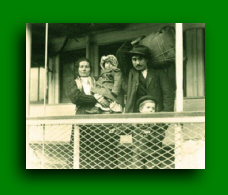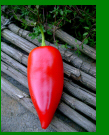THE HEIRLOOM CHILES:
 The heirloom peppers are old varieties of family handed down from generation to generation. Often taking origin from different ethnic groups of immigrants throughout history have moved around the world by crossing their seed with other varieties, in order to improve or develop particular aromas, colors, yields and ability of plants to survive in particular climates. In many cases they have been grown by certain families in a restricted environment for hundreds of years, developing over time a stable varieties and unknown to most people. Most heirloom chillies are part of the species Capsicum annuum, probably due to its versatility with respect to other species. By tradition, all heirlooms are open-pollinated to allow the plants to adapt slowly to the local growing conditions and climate from year to year. The open pollination is when pollination takes place by means of natural mechanisms, such as bees and other pollinating insects. According to some companies, a culture is considered a true heirloom once you are past 50 or 100 years of stable varieties. However, the current thinking of the farmers fans do not agree on these timescales. Almost everyone agrees that a true heirloom is a growing open-pollinated and therefore always subject to a slow mutation and which is still genetically unique compared to typical commercial varieties available today. Although it is not a matter of fact, many farmers also point out that the main advantage of heirloom have their own unique taste and aroma. The heirloom are thus a gift that transcends time, pieces of history that enclose passion and tradition.
The heirloom peppers are old varieties of family handed down from generation to generation. Often taking origin from different ethnic groups of immigrants throughout history have moved around the world by crossing their seed with other varieties, in order to improve or develop particular aromas, colors, yields and ability of plants to survive in particular climates. In many cases they have been grown by certain families in a restricted environment for hundreds of years, developing over time a stable varieties and unknown to most people. Most heirloom chillies are part of the species Capsicum annuum, probably due to its versatility with respect to other species. By tradition, all heirlooms are open-pollinated to allow the plants to adapt slowly to the local growing conditions and climate from year to year. The open pollination is when pollination takes place by means of natural mechanisms, such as bees and other pollinating insects. According to some companies, a culture is considered a true heirloom once you are past 50 or 100 years of stable varieties. However, the current thinking of the farmers fans do not agree on these timescales. Almost everyone agrees that a true heirloom is a growing open-pollinated and therefore always subject to a slow mutation and which is still genetically unique compared to typical commercial varieties available today. Although it is not a matter of fact, many farmers also point out that the main advantage of heirloom have their own unique taste and aroma. The heirloom are thus a gift that transcends time, pieces of history that enclose passion and tradition. Unfortunately, some varieties are already extinct, and many other plants are disappearing at an alarming rate. But thanks to the ongoing efforts of Dr. William Woys Weaver, of groups of Native Americans, Amish and Mennonite communities, which have long been engaged in the collection and storage of vegetable seeds ancients, and by companies and specialized associations such as the Seed Savers Exchange, together are ensuring that these plants are not extinguished in time.
Unfortunately, some varieties are already extinct, and many other plants are disappearing at an alarming rate. But thanks to the ongoing efforts of Dr. William Woys Weaver, of groups of Native Americans, Amish and Mennonite communities, which have long been engaged in the collection and storage of vegetable seeds ancients, and by companies and specialized associations such as the Seed Savers Exchange, together are ensuring that these plants are not extinguished in time.
SOME HEIRLOOM VARIETY:
 Jimmy Nardello: (Capsicum annuum) heirloom variety from Italy. Grown every year since Giuseppe and Angela Nardiello to Ruoti in Basilicata. The Nardiello family emigrated in 1887 in Naugatuck, Connecticut. This variety is named after their fourth son Jimmy. The seeds were donated by Jimmy Nardiello to the Seed Savers Exchange in 1980.
Jimmy Nardello: (Capsicum annuum) heirloom variety from Italy. Grown every year since Giuseppe and Angela Nardiello to Ruoti in Basilicata. The Nardiello family emigrated in 1887 in Naugatuck, Connecticut. This variety is named after their fourth son Jimmy. The seeds were donated by Jimmy Nardiello to the Seed Savers Exchange in 1980.
 Fish Pepper: (Capsicum annuum) An heirloom variety dating from between 1800 and the beginning of 1900. Hugely popular in the African American communities in the area between Baltimore and Philadelphia. The grandfather of Dr. William Woys Weaver received the seeds in 1940 by Horace Pippin, a black painter popular in West Chester, Pennsylvania, in exchange for a cure based on bee stings to combat the pains of arthritis. Dr. Weaver in 1995 shared the seeds through Seed Savers Exchange.
Fish Pepper: (Capsicum annuum) An heirloom variety dating from between 1800 and the beginning of 1900. Hugely popular in the African American communities in the area between Baltimore and Philadelphia. The grandfather of Dr. William Woys Weaver received the seeds in 1940 by Horace Pippin, a black painter popular in West Chester, Pennsylvania, in exchange for a cure based on bee stings to combat the pains of arthritis. Dr. Weaver in 1995 shared the seeds through Seed Savers Exchange.
 Martin’s Carrot Pepper: (Capsicum annuum) This heirloom, rare and very old, is believed to have been introduced or developed in the 19th century by a horticulturist Mennonite, Jacob B. Garber (1800 - 1886) in Lancaster County in Pennsylvania. It been preserved for many years by the Martin family of Ephrata, Pennsylvania. Dr. Weaver acquired varieties directly from the Martin family in 1971 and then donated to the Seed Savers Exchange in 1996.
Martin’s Carrot Pepper: (Capsicum annuum) This heirloom, rare and very old, is believed to have been introduced or developed in the 19th century by a horticulturist Mennonite, Jacob B. Garber (1800 - 1886) in Lancaster County in Pennsylvania. It been preserved for many years by the Martin family of Ephrata, Pennsylvania. Dr. Weaver acquired varieties directly from the Martin family in 1971 and then donated to the Seed Savers Exchange in 1996.
 Willings Barbados: (Capsicum annuum var. Aviculare) The Willings Barbardos Bird Pepper is an heirloom variety. Landrace varieties originating from Barbados named after the merchant Charles Willing (1738-1788), who in 1760 took him to the botanist John Bertram for the collection of the passionate botanist Sir John St. Clair at his estate near Trenton, New Jersey. From there it passed to the Cooper family near Camden, New Jersey, and then to Mahlon Luna, a Quaker nurseryman in Morrisville, Pennsylvania. These two families spread widely among the top seeds and the mid-1800s among growers in the region of Philadelphia and Baltimore. In Philadelphia the pepper Willings Barbados was also known as Barberry pepper or Pipperidge pepper.
Willings Barbados: (Capsicum annuum var. Aviculare) The Willings Barbardos Bird Pepper is an heirloom variety. Landrace varieties originating from Barbados named after the merchant Charles Willing (1738-1788), who in 1760 took him to the botanist John Bertram for the collection of the passionate botanist Sir John St. Clair at his estate near Trenton, New Jersey. From there it passed to the Cooper family near Camden, New Jersey, and then to Mahlon Luna, a Quaker nurseryman in Morrisville, Pennsylvania. These two families spread widely among the top seeds and the mid-1800s among growers in the region of Philadelphia and Baltimore. In Philadelphia the pepper Willings Barbados was also known as Barberry pepper or Pipperidge pepper.
 Hinkelhatz: (Capsicum annuum) Grown in Pennsylvania Dutch Mennonite settlers since 1880 by immigrants from southwestern Germany and Switzerland who settled in Pennsylvania during the 17th and 18th centuries. It's a chili heirloom rare that translates to "chicken heart", a description of its shape and size. This variety is one of the oldest preserved by this group of Mennonites, cultivated for over 150 years. The fruits are usually red or yellow, although there is a variation of orange, very rare and preserved by a small group of farmers in Maxatawy Mennonites, Pennsylvania. Considered to be quite spicy, the Hinkelhatz is traditionally used exclusively for the brine. Cited as an ingredient in the recipe book "Die Geschickte Hausfrau" of 1848, for a vinegar sauce often sprayed on sauerkraut.
Hinkelhatz: (Capsicum annuum) Grown in Pennsylvania Dutch Mennonite settlers since 1880 by immigrants from southwestern Germany and Switzerland who settled in Pennsylvania during the 17th and 18th centuries. It's a chili heirloom rare that translates to "chicken heart", a description of its shape and size. This variety is one of the oldest preserved by this group of Mennonites, cultivated for over 150 years. The fruits are usually red or yellow, although there is a variation of orange, very rare and preserved by a small group of farmers in Maxatawy Mennonites, Pennsylvania. Considered to be quite spicy, the Hinkelhatz is traditionally used exclusively for the brine. Cited as an ingredient in the recipe book "Die Geschickte Hausfrau" of 1848, for a vinegar sauce often sprayed on sauerkraut.
 Beaver Dam Pepper: (Capsicum annuum) Rare Hungarian heirloom considered one of the foods in danger of extinction. Brought to Beaver Dam, Wisconsin in 1912 by the family of Joe Hussli, a Hungarian immigrant. Farmers and chefs in Milwaukee are sensitizing the Beaver Dam Pepper by presenting cooking demonstrations on restaurant menus in order to draw attention to what they say is one of the thousands of forgotten vegetables and endangered. The Slow Food Foundation for Biodiversity estimated 300,000 plant varieties have been lost in the last century. "Each of these losses is the loss of the history of a family," said Jennifer Casey, head of Slow Food Wisconsin.
Beaver Dam Pepper: (Capsicum annuum) Rare Hungarian heirloom considered one of the foods in danger of extinction. Brought to Beaver Dam, Wisconsin in 1912 by the family of Joe Hussli, a Hungarian immigrant. Farmers and chefs in Milwaukee are sensitizing the Beaver Dam Pepper by presenting cooking demonstrations on restaurant menus in order to draw attention to what they say is one of the thousands of forgotten vegetables and endangered. The Slow Food Foundation for Biodiversity estimated 300,000 plant varieties have been lost in the last century. "Each of these losses is the loss of the history of a family," said Jennifer Casey, head of Slow Food Wisconsin.
 Chervena Chushka: (Capsicum annuum) Also known as Chervena Chujski. It's a heirloom of Bulgarian origin traditionally used for drying and the production of paprika, but also excellent eaten fresh.
Chervena Chushka: (Capsicum annuum) Also known as Chervena Chujski. It's a heirloom of Bulgarian origin traditionally used for drying and the production of paprika, but also excellent eaten fresh.
 Doe Hill Pepper: (Capsicum annuum) is an heirloom very rare, cultivated since before 1900 in the area of Doe Hill, Highland County, Virginia. Very early, very productive, disease resistant and pumpkin-shaped fruit.
Doe Hill Pepper: (Capsicum annuum) is an heirloom very rare, cultivated since before 1900 in the area of Doe Hill, Highland County, Virginia. Very early, very productive, disease resistant and pumpkin-shaped fruit.
 Bull Nose: (Capsicum annuum) Grown by Thomas Jefferson in his estate "Monticello".
Bull Nose: (Capsicum annuum) Grown by Thomas Jefferson in his estate "Monticello".

